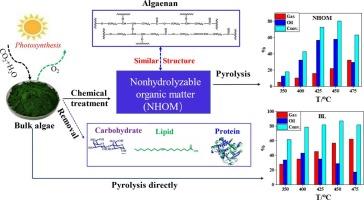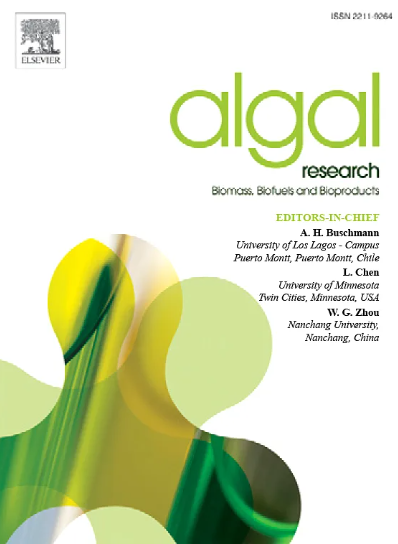蓝藻 Schizothrix calcicole 及其抗性生物聚合物的化学结构和碳氢化合物生成潜力
IF 4.5
2区 生物学
Q1 BIOTECHNOLOGY & APPLIED MICROBIOLOGY
Algal Research-Biomass Biofuels and Bioproducts
Pub Date : 2024-11-03
DOI:10.1016/j.algal.2024.103786
引用次数: 0
摘要
微藻在开发可持续生物燃料方面具有巨大潜力,因此备受关注。本研究将蓝藻 Schizothrix calcicole 分成不同的馏分,并通过元素分析、Rock-Eval 高温分解和 13C NMR 对其进行表征。对 S. calcicole 的块状(BL)样品及其非水解有机物(NHOM)部分进行了封闭式热解实验。结果表明,NHOM 部分由饱和、无支链或弱支链的烃链组成,链长可达 32,是高度脂肪族抗性生物聚合物,其结构类似于藻聚糖,与 BL 样品相比,具有更高的产油率(58.1%)和油气生产潜力(OGPs,63.9%)。此外,NHOM 部分的正构烷烃呈双峰分布,以 C15 以上的长链为主。相反,BL 样品中的正构烷烃呈单峰分布,其中链长为 <17 的中链和短链正构烷烃含量较高。此外,研究结果表明 13C NMR 是评估碳氢化合物生成潜力的有效方法。我们的研究发现了蓝藻 S. calcicole 中的脂肪族生物聚合物,并加深了对其不同部分碳氢化合物生成情况的了解。本文章由计算机程序翻译,如有差异,请以英文原文为准。

Chemical structure and hydrocarbon generation potentials of cyanobacteria Schizothrix calcicole and its resistant biopolymer
Microalgae have attracted much attention because of their great potential in the development of sustainable biofuel. In this study, cyanobacteria Schizothrix calcicole was fractionated into different fractions and characterized by elemental analyses, Rock-Eval pyrolysis, and 13C NMR. Closed pyrolysis experiments were carried out on the bulk (BL) sample of S. calcicole and its nonhydrolyzable organic matter (NHOM) fraction. The results suggested the NHOM fraction was composed of a saturated and unbranched or weakly branched hydrocarbon chain with a chain length up to 32, which was highly aliphatic resistant biopolymer similar to algaenan in structure, and exhibited higher oil yield (58.1 %) and oil and gas production potentials (OGPs, 63.9 %) than the BL sample did. Moreover, the n-alkanes for the NHOM fraction showed bimodal distribution and were dominated by long chains higher than C15. On the contrary, the BL sample exhibited unimodal distribution of n-alkanes, in which middle- and short-chain n-alkanes with chain length <17 were more abundant. In addition, the results indicated 13C NMR is an effective approach to evaluate hydrocarbon generation potentials. Our investigation identifies aliphatic biopolymers in cyanobacteria S. calcicole and improves the understanding of hydrocarbon generation of its different fractions.
求助全文
通过发布文献求助,成功后即可免费获取论文全文。
去求助
来源期刊

Algal Research-Biomass Biofuels and Bioproducts
BIOTECHNOLOGY & APPLIED MICROBIOLOGY-
CiteScore
9.40
自引率
7.80%
发文量
332
期刊介绍:
Algal Research is an international phycology journal covering all areas of emerging technologies in algae biology, biomass production, cultivation, harvesting, extraction, bioproducts, biorefinery, engineering, and econometrics. Algae is defined to include cyanobacteria, microalgae, and protists and symbionts of interest in biotechnology. The journal publishes original research and reviews for the following scope: algal biology, including but not exclusive to: phylogeny, biodiversity, molecular traits, metabolic regulation, and genetic engineering, algal cultivation, e.g. phototrophic systems, heterotrophic systems, and mixotrophic systems, algal harvesting and extraction systems, biotechnology to convert algal biomass and components into biofuels and bioproducts, e.g., nutraceuticals, pharmaceuticals, animal feed, plastics, etc. algal products and their economic assessment
 求助内容:
求助内容: 应助结果提醒方式:
应助结果提醒方式:


